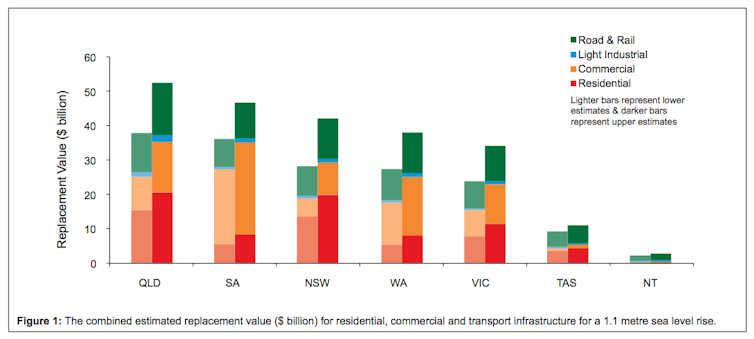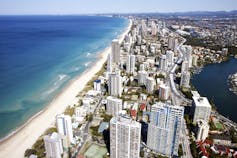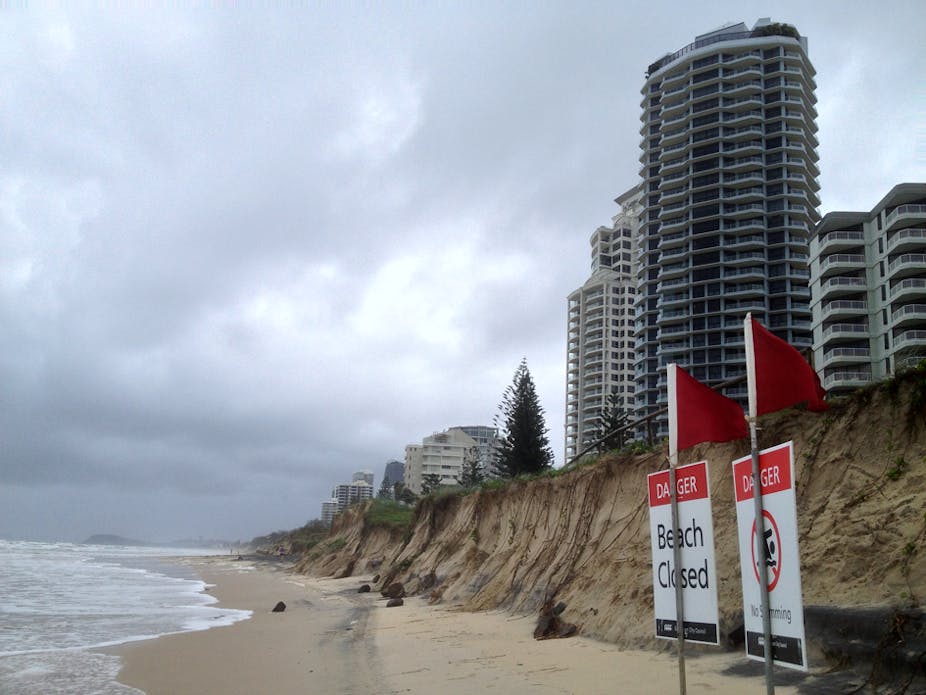As the science on the coastal impacts of climate change gets stronger, the protections for Australia’s coastal communities are getting weaker. If that continues, everyone will pay.
Along the eastern seaboard of Australia, where most of us live, state governments are relaxing their policies and largely leaving it to local councils to decide if homes can be built in low-lying areas.
The Queensland government confirmed this week that sea level rise will be removed from its State Planning Policy, just as it was in New South Wales a year ago, while Victoria has also relaxed its sea level rules.
Yet nearly 39,000 homes are already located within 110 metres of soft, erodible shorelines, according to the Australian Department of Environment, which states exposure to the effects of sea level rise “will increase as Australia’s population grows”.
With 85% of Australians living in coastal areas, and billions of dollars of buildings and roads at stake, if we don’t get coastal planning right we risk facing huge human and economic costs.
The Local Government Association of Queensland has warned that councils could be sent broke by the state policy change, particularly because of the legal liability they could face if they approve coastal developments that are subsequently hit by future storm damage or flooding.
And as we saw with the devastating Queensland floods of 2011 and other major disasters, when individual homeowners were not insured and needed help, or when individual councils can’t afford to fix damaged roads and infrastructure, who ends up footing much of the repair bill? All Australian taxpayers.
So this is not just a problem for the lucky few with homes by the beach: we all have something at stake in getting coastal protections right.
Sea level rise science
As the Department of Environment explains, the risks from rising sea levels are serious, and not limited just to the coast:

Rising sea levels will increase the frequency or likelihood of extreme sea level events and resultant flooding. The risks from sea level rise are not confined to the coast itself. In many cases flooding may impact areas some distance from the sea for example along estuaries, rivers, lakes and lagoons.
A study of 29 locations in Australia found that for a mid-range sea level rise of 50cm, extreme sea level events that happened every few years now are likely to occur every few days in 2100.
On average, Australia will experience a roughly 300-fold increase in flooding events, meaning that infrastructure that is presently flooded once in 100 years will be flooded several times per year with a sea level rise of 50cm.
But when you consider that many homes and suburbs that we build in Australia today will still be standing for decades to come, and that we don’t want to see those home owners left out of pocket or suing their council for letting them build in low-lying areas - just how much sea level rise should we be planning for?
I asked Dr John Church, a CSIRO Fellow and a coordinating lead author of the Intergovernmental Panel on Climate Change chapter on sea level, what the latest science indicated. He replied:
The science is clear. Historical sea level information around the world and in Australia tells us that in times of a warmer climate, sea level has been metres higher than at present and that the rate of sea level rise has increased since pre-industrial time.
The emission of greenhouse gases has been a significant contribution to the 20th century rise and will very likely result in a faster rate of rise during the 21st century than over the last 40 years, or the 20th century as a whole.
Projections for sea level rise around Australia are similar to the global average. If there was very significant mitigation of greenhouses gas emissions, the global average rise is projected to be 28cm to 61cm by 2100, but, if emissions continue to grow in a business as usual fashion as is happening at present, the rise is projected to be 52cm to 98cm, and possibly up to several tens of centimetres above these values if marine-based sectors of the Antarctic ice sheet collapse. Sea level will continue to rise well after 2100. - John Church, correspondence with the author, 9 December 2013.
Queensland’s old planning rules had factored in a sea level rise of 30 centimetres by 2050 and 80 centimetres by 2100. That meant that coastal development in such hazard areas was generally only permitted in special circumstances, such as for marine and fishing precincts .
As Dr Church and the Australian government’s sea level site both indicate, on current trends 80cm is within the range of business as usual projections.
A 2011 report by the Australian government found that more than A$226 billion worth of Australian homes, offices blocks, roads, rail and other built infrastructure would be potentially flooded or eroded with a sea level rise of 1.1 metres, which is the high end scenario they examined for 2100.
Ironically, of all Australian states, that report found Queensland faced the greatest combined risk from high tides and storm surges, and the costs they would face to replace damaged infrastructure. (The state-by-state cost estimates are shown below.)

A national response to a national problem
In the two short years since that report was published, we have gone from a situation where all Australian governments were working together on a national approach to coastal planning, under the former National Coasts and Climate Change Council, to a trend towards dumping the risks and liabilities for coastal planning onto local councils.
This is already leaving some communities very exposed to rising costs. For instance, the Gold Coast is already hit by beach erosion costing tens of millions of dollars to remedy, and even greater costs could be incurred with further seawater intrusion and damage to infrastructure, such as storm water networks.

Yet there is plenty of evidence to show why protecting coastal areas is the sensible option, and how to do it.
Over the past 50 years, there have been 25 national inquiries and reports into coastal management, including a comprehensive 396-page 2009 Coasts and Climate Change federal parliamentary report. Those inquiries have overwhelmingly come to the conclusion that rather than leaving it to local councils, we need one set of clear, national guidelines on coastal development and infrastructure.
That’s the opposite of what we’re now seeing around Australia, with a mish-mash of different rules in different states.
All of which increases the risk of more development in areas at risk of coastal erosion, sea level rise and storm surges. Unless this changes, who’ll pay the price for this lack of foresight and planning? If you’re an Australian taxpayer, you will, and in the future so will your children.

